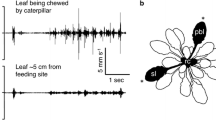Summary
ThePhysarum plasmodium shows rhythmic contractile activities with a period of a few min. Phases of the oscillation in the plasmodium migrating unindirectionally agreed sideways throughout at the frontal part. So, time course of an intracellular chemical component was determined by analyzing small pieces cut off successively from the frontal part of the large plasmodium. Intracellular NAD(P)H concentration oscillated with the same period as the rhythmic contraction but with a different phase advancing about 1/3 of the period. UV irradiation suppressed the rhythmic contraction without affecting the rhythmic variation of NAD(P)H. Thus, the NAD(P)H oscillator works independently of the rhythmic contractile system, but seems entraining with each other.
Similar content being viewed by others
Abbreviations
- UV:
-
ultraviolet
- NADH:
-
nicotinamide adenine dinucleotide, reduced form
- NADPH:
-
nicotinamide adenine dinucleotide phosphate, reduced form
- ATP:
-
adenosine 5′-triphosphate
- cAMP:
-
cyclic adenosine 3′, 5′-monophosphate
- FMNH2 :
-
flavin mononucleotide, reduced form
- TCA:
-
tricarboxylic acid
- BSA:
-
bovine serum albumin
- DTT:
-
dithiothreitol
References
Baranowski Z (1985) Consequences of impeding in mitochondrial functions inPhysarum polycephalum. III. Reversible cessation of the contraction-relaxation cycle and the temperature sensitivity of the alternate respiratory pathway. Eur J Cell Biol 39: 283–289
Hess B (1983) Non-equilibrium dynamics of biochemical processes. Hoppe-Seyler's Z Physiol Chem 364: 1–20
Ishigami M (1986) Dynamic aspects of the contractile system inPhysarum plasmodium: I. Changes in spatial organization of the cytoplasrnic fibrils according to the contraction-relaxation cycle. Cell Motility and Cytoskeleton 6: 439–447
—,Nagai R, Kuroda K (1981) A polarized light and electron microscopic study of the birefringent fibrils inPhysarum plasmodia. Protoplasma 109: 91–102
Kamiya N, Abe S, Nakajima H (1957) Simultaneous measurement of respiration and the motive force of protoplasmic streaming in the myxomycete plasmodium. I. outline of the method. Proc Japan Acad 33: 206–210
— (1959) Protoplasmic streaming. Protoplasmatologia 8: 1–199
Korohada W, Shraideh Z, Baranowski Z, Wohlfarth-Bottermann KE (1983) Energy metabolic regulation of oscillatory contractile activity inPhysarum polycephalum. Cell Tiss Res 231: 675–691
Matsumoto K, Ueda T, Kobatoke Y (1986) Propagation of phase wave in relation to tactic responses by the plasmodium ofPhysarum polycephalum. J theor Biol 122: 339–345
Nagai R, Yoshimoto Y, Kamiya N (1978) Cyclic production of tension force in the plasmodial strand ofPhysarum polycephalum and its relation to microfilament morphology. J Cell Sci 33: 205–225
Naib-Majani W, Stockem W, Wohlfarth-Bottermann KE (1982) Immunocytochemistry of the acellular slime moldPhysarum polycephalum. II. Spatial organization of cytoplasmic actin. Eur J Cell Biol 28: 103–104
Nakamura S, Kamiya N (1985) Oscillation in cytoplasmic pH ofPhysarum plasmodium in relation to motility. Cell Struct Funct 10: 133–134
Nicolis G, Prigogine I (1977) Self-organization in nonequilibrium systems. John Wiley & Sons, Inc, New York
Satoh H, Ueda T, Kobatake Y (1982) Primary oscillator of contractional rhythm in the plasmodium ofPhysarum polycephalum: role of mitochondria. Cell Struct Funct 7: 381–396
— — — (1984) Rhythmic contraction in the plasmodium of the myxomycetePhysarum polycephalum. Cell Struct Funct 9: 37–42
Stanley PE (1971) Determination of subpicomole levels of NADH and FMN using bacterial luciferase and the liquid scintillation spectrometer. Anal Biochem 39: 441–53
Ueda T, Matsumoto K, Akitaya T, Kobatake Y (1986) Spatial and temporal organization of intracellular adenine nucleotides and cyclic nucleotides in relation to rhythmic motility inPhysarum plasmodium. Exp Cell Res 162: 486–494
Watanabe M, Furuya M, Miyoshi Y, Inoue Y, Iwahashi I, Matsumoto K (1982) Design and performance of the Okazaki large spectrograph for photobiological research. Photochem Photobiol 36: 491–498
Wohlfarth-Bottermann KE, Fleischer M (1976) Cyclic aggregation patterns of cytoplasmic F-actin coordinated with oscillating tension force generation. Cell Tiss Res 165: 327–344
Yoshimoto Y, Sakai T, Kamiya N (1981) ATP oscillation inPhysarum plasmodium. Protoplasma 109: 159–168
—,Matsumura F, Kamiya N (1981) Simultaneous oscillations of calcium(2+) efflux and tension generation in the permealized plasmodial strand ofPhysarum. Cell Motility 1 (4): 433–443
Author information
Authors and Affiliations
Rights and permissions
About this article
Cite this article
Mori, Y., Ueda, T. & Kobatake, Y. NAD(P)H oscillation in relation to the rhythmic contraction in thePhysarum plasmodium. Protoplasma 139, 141–144 (1987). https://doi.org/10.1007/BF01282284
Received:
Accepted:
Issue Date:
DOI: https://doi.org/10.1007/BF01282284




